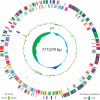The complete genome and proteome of Mycoplasma mobile
- PMID: 15289470
- PMCID: PMC509254
- DOI: 10.1101/gr.2674004
The complete genome and proteome of Mycoplasma mobile
Abstract
Although often considered "minimal" organisms, mycoplasmas show a wide range of diversity with respect to host environment, phenotypic traits, and pathogenicity. Here we report the complete genomic sequence and proteogenomic map for the piscine mycoplasma Mycoplasma mobile, noted for its robust gliding motility. For the first time, proteomic data are used in the primary annotation of a new genome, providing validation of expression for many of the predicted proteins. Several novel features were discovered including a long repeating unit of DNA of approximately 2435 bp present in five complete copies that are shown to code for nearly identical yet uniquely expressed proteins. M. mobile has among the lowest DNA GC contents (24.9%) and most reduced set of tRNAs of any organism yet reported (28). Numerous instances of tandem duplication as well as lateral gene transfer are evident in the genome. The multiple available complete genome sequences for other motile and immotile mycoplasmas enabled us to use comparative genomic and phylogenetic methods to suggest several candidate genes that might be involved in motility. The results of these analyses leave open the possibility that gliding motility might have arisen independently more than once in the mycoplasma lineage.
Copyright 2004 Cold Spring Harbor Laboratory Press ISSN
Figures





Similar articles
-
The minimal cellular genome of mycoplasma.Indian J Biochem Biophys. 1997 Feb-Apr;34(1-2):124-30. Indian J Biochem Biophys. 1997. PMID: 9343940
-
Phylogenetic framework for the phylum Tenericutes based on genome sequence data: proposal for the creation of a new order Mycoplasmoidales ord. nov., containing two new families Mycoplasmoidaceae fam. nov. and Metamycoplasmataceae fam. nov. harbouring Eperythrozoon, Ureaplasma and five novel genera.Antonie Van Leeuwenhoek. 2018 Sep;111(9):1583-1630. doi: 10.1007/s10482-018-1047-3. Epub 2018 Mar 20. Antonie Van Leeuwenhoek. 2018. PMID: 29556819
-
Mycoplasma genomics: tailoring the genome for minimal life requirements through reductive evolution.Front Biosci. 2007 Jan 1;12:2020-8. doi: 10.2741/2207. Front Biosci. 2007. PMID: 17127440 Review.
-
Persistence of Functional Protein Domains in Mycoplasma Species and their Role in Host Specificity and Synthetic Minimal Life.Front Cell Infect Microbiol. 2017 Feb 7;7:31. doi: 10.3389/fcimb.2017.00031. eCollection 2017. Front Cell Infect Microbiol. 2017. PMID: 28224116 Free PMC article.
-
Genomic Islands in Mycoplasmas.Genes (Basel). 2020 Jul 22;11(8):836. doi: 10.3390/genes11080836. Genes (Basel). 2020. PMID: 32707922 Free PMC article. Review.
Cited by
-
Analysis of the secretome and identification of novel constituents from culture filtrate of bacillus Calmette-Guerin using high-resolution mass spectrometry.Mol Cell Proteomics. 2013 Aug;12(8):2081-95. doi: 10.1074/mcp.M113.027318. Epub 2013 Apr 24. Mol Cell Proteomics. 2013. PMID: 23616670 Free PMC article.
-
"Mycoplasmal antigen modulation," a novel surface variation suggested for a lipoprotein specifically localized on Mycoplasma mobile.Curr Microbiol. 2012 May;64(5):433-40. doi: 10.1007/s00284-012-0090-y. Epub 2012 Feb 15. Curr Microbiol. 2012. PMID: 22349955
-
Periodicity in Attachment Organelle Revealed by Electron Cryotomography Suggests Conformational Changes in Gliding Mechanism of Mycoplasma pneumoniae.mBio. 2016 Apr 12;7(2):e00243-16. doi: 10.1128/mBio.00243-16. mBio. 2016. PMID: 27073090 Free PMC article.
-
Comparative genomics of Mycoplasma: analysis of conserved essential genes and diversity of the pan-genome.PLoS One. 2012;7(4):e35698. doi: 10.1371/journal.pone.0035698. Epub 2012 Apr 20. PLoS One. 2012. PMID: 22536428 Free PMC article.
-
Detection of Steps and Rotation in the Gliding Motility of Mycoplasma mobile.Methods Mol Biol. 2023;2646:327-336. doi: 10.1007/978-1-0716-3060-0_27. Methods Mol Biol. 2023. PMID: 36842127
References
-
- Aluotto, B.B., Wittler, R.G., Williams, C.O., and Faber, J.E. 1970. Standardized bacteriologic techniques for the characterization of mycoplasma species. Intl. J. Syst. Bacteriol. 20: 35–58.
WEB SITE REFERENCES
-
- http://arep.med.harvard.edu/mycoplasma/; G.M. Church, Harvard University Medical School.
-
- http://www.broad.mit.edu/annotation/microbes/mycoplasma/; Mycoplasma mobile genome project.
-
- http://www.ncbi.nlm.nih.gov/COG/; NCBI, National Institues of Health.
Publication types
MeSH terms
Substances
Associated data
- Actions
Grants and funding
LinkOut - more resources
Full Text Sources
Other Literature Sources
Molecular Biology Databases
Miscellaneous
